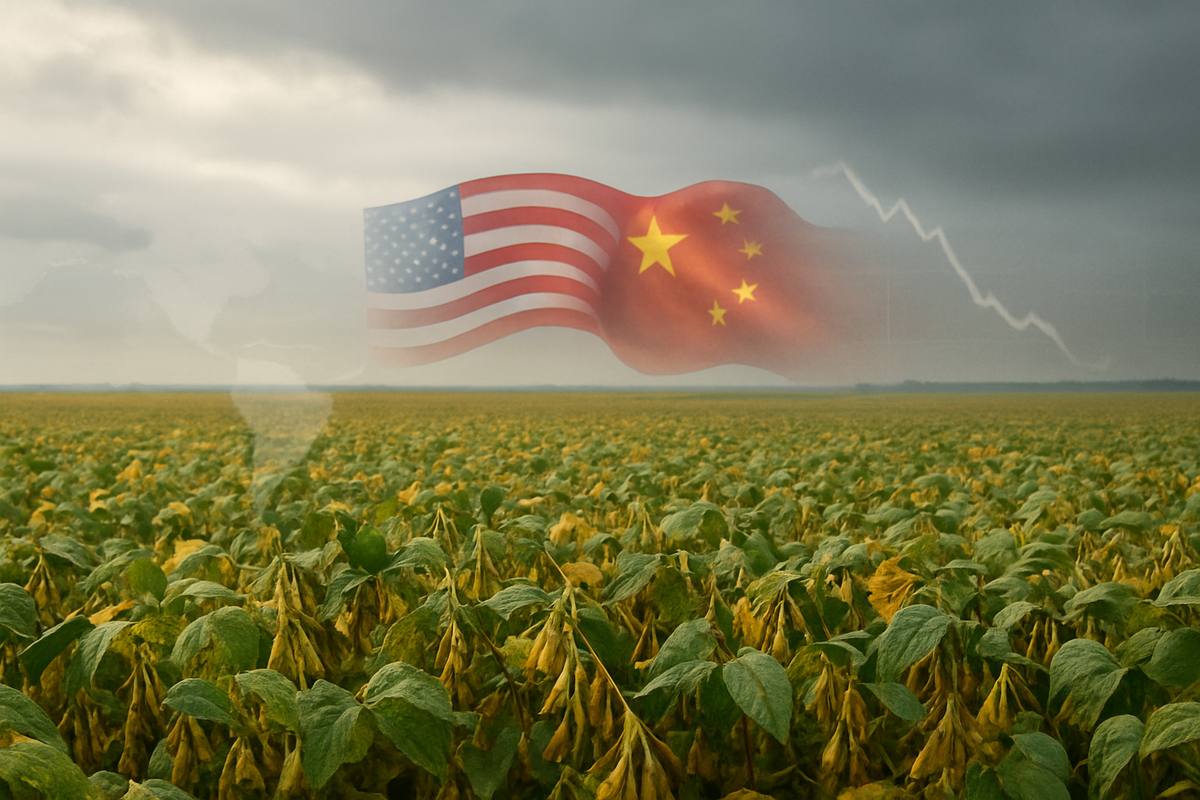
The eagerly anticipated U.S.-China trade deal, once hailed as a potential turning point for the embattled American agricultural sector, has been met with a remarkably underwhelming reaction in soybean futures. Instead of the robust rally many had hoped for, the market's response has been muted, raising critical questions for investors and farmers alike. As of October 30, 2025, the subdued price action suggests that either the deal's positive implications were largely priced in ahead of time, or other significant factors are at play, fundamentally reshaping the global soybean landscape.
This muted market sentiment casts a long shadow over the future of U.S. agricultural exports to China, highlighting a potential new normal where geopolitical agreements may no longer carry the same immediate market-moving weight they once did. The lack of concrete, specific purchasing commitments from China appears to be a key driver behind the market's cautious approach, leaving traders to ponder the true, long-term impact of the agreement.
A Deal of Diminished Returns: The Nuances of an Underwhelming Reaction
The lead-up to the U.S.-China trade deal was characterized by a period of cautious optimism, with soybean futures on the Chicago Board of Trade (CBOT) experiencing a rally that saw prices climb, reaching approximately $10.98 to $11.06-1/2 per bushel. This bullish sentiment was fueled by indications from U.S. officials, including Treasury Secretary Scott Bessent, that China was poised to make "substantial" purchases of U.S. soybeans. Ahead of the official announcement, China's state-owned COFCO reportedly made preliminary purchases, further stoking expectations.
However, upon the official announcement of the trade framework around October 30, 2025, the market's reaction was far from enthusiastic. Instead of a sustained ascent, the most-active soybean contract on the CBOT declined by 1.9% to $10.74-1/4 a bushel. This "buy the rumor, sell the fact" phenomenon was primarily driven by the absence of specific, actionable details regarding China's purchasing commitments. While President Trump spoke of "tremendous" volumes, neither side provided concrete quantities or a firm timeline, leaving traders disappointed. Analysts like Andrew Whitelaw of Episode 3 noted that the market expected a "concrete" deal, which was not delivered.
Adding to the skepticism was China's past track record of making similar promises without full delivery, particularly under the 2020 "Phase One" trade deal. The trade dispute had also pushed China to significantly diversify its soybean suppliers, heavily favoring South American nations like Brazil and Argentina. This strategic shift meant that even substantial U.S. purchases might not fully restore the U.S. market share to pre-trade war levels, as Brazil had solidified its position as a dominant supplier. Broader market cautiousness, influenced by comments from Federal Reserve Chair Jerome Powell, also contributed to the subdued commodity market sentiment.
Corporate Crossroads: Winners, Losers, and Strategic Shifts
The fluctuating dynamics of U.S.-China soybean trade have had a profound and often contradictory impact on public companies across the agricultural value chain. While a trade deal theoretically benefits the sector, the underwhelming market reaction highlights the complexities.
Agribusiness giants like Archer Daniels Midland (NYSE: ADM) and Bunge Global SA (NYSE: BG) have navigated these turbulent waters with a degree of resilience due to their global diversification. While disrupted trade flows and lower U.S. soybean demand initially impacted their operating profits, their extensive operations in Brazil allowed them to leverage South American sourcing to continue supplying China, partially offsetting losses. Furthermore, recent threats by President Trump to embargo Chinese cooking oils in retaliation for reduced U.S. soybean purchases are seen as a significant win for ADM and Bunge, as major oilseed processors and soybean oil producers in the U.S. A shortage of imported used cooking oil would likely boost demand for domestic soybean oil, a factor that saw ADM's shares soar and Bunge's jump over 13%. The new framework agreement, with China committing to substantial U.S. soybean purchases, is also expected to improve their grain origination and processing segments.
Conversely, agricultural equipment manufacturers like Deere & Company (NYSE: DE), a bellwether for farmer sentiment, have faced significant headwinds. U.S. farmers, grappling with uncertain demand, depressed soybean prices, and high input costs, have been reluctant to invest in new machinery. This hesitancy directly led to lowered financial outlooks for Deere, production cuts at its factories, and increased tariff-related costs. While a stable trade agreement could restore farmer confidence and stimulate equipment demand, the actual translation into increased sales hinges on sustained farmer profitability and long-term trade stability, which remains uncertain.
Corteva (NYSE: CTVA), a leading producer of seeds and crop protection products, has also felt the ripple effects. Lower soybean prices make farmers more sensitive to input costs, impacting sales of seeds and herbicides. While the company initially projected a larger tariff impact, temporary deals have helped mitigate some of the damage. A healthier, more stable soybean market, spurred by renewed trade, would generally benefit Corteva by encouraging farmers to invest in higher-yielding seeds and effective crop protection.
Shipping companies, crucial for transporting agricultural commodities, have also experienced a mixed bag. The trade war disrupted traditional shipping routes, as China shifted its sourcing away from the U.S. to South America. While the recent commitment to purchase U.S. soybeans is expected to increase export volumes, particularly through Gulf and Pacific Northwest terminals, potentially boosting cargo volumes and revenues, new challenges loom. Proposed U.S. administration fees on Chinese-built and -operated ships could significantly increase freight rates, making U.S. agricultural products less competitive globally and potentially offsetting gains from increased volumes.
Beyond the Deal: A Shifting Global Agricultural Landscape
The underwhelming market reaction to the U.S.-China soybean trade deal is more than just a momentary blip; it signifies a profound and potentially permanent shift in global agricultural trade dynamics. This event is deeply embedded in broader industry trends, particularly China's unwavering commitment to food security and the growing dominance of South American suppliers.
China views food security as an "existential priority" and has actively pursued a strategy of diversifying its import sources and boosting domestic production to reduce its vulnerability to geopolitical swings. The 2018 trade war merely accelerated this existing policy, pushing China to solidify its reliance on Brazil and Argentina. This has created a "bifurcated" global soybean market, where China's massive demand is increasingly met by South America, potentially permanently altering traditional trade flows. Even with new agreements, the market acknowledges this long-term reorientation.
The ripple effects are substantial. Brazil and Argentina have emerged as the primary beneficiaries of this shift, significantly increasing their soybean production and exports to China. This has come at the expense of U.S. farmers, who have faced depressed prices and lost market share, forcing them to seek alternative markets and adapt to a more competitive global landscape. The long-term impact on U.S. agriculture points to a necessity for greater diversification of crops and export destinations.
Regulatory and policy implications are also significant. China's actions underscore a strong policy directive to enhance self-sufficiency and diversify supply. For the U.S., this places pressure on farm policy to support farmers in adapting to new market demands, maintaining crop quality, and aligning with export logistics beyond China. The ongoing presence or threat of trade tariffs continues to shape these flows, highlighting how political decisions can fundamentally alter economic realities. Historically, this mirrors the 1980s grain embargo, which ultimately hurt U.S. producers while foreign competitors capitalized, demonstrating the long-term damage of trade disputes in agriculture.
The Road Ahead: Navigating a New Normal
The future for soybean futures and the U.S.-China trade relationship is poised for continued complexity. While the recent trade framework, which includes China's commitment to purchase 12 million metric tons of U.S. soybeans through January 2026 and 25 million tons annually for the next three years, has provided some short-term price support, analysts remain cautious. This is widely seen as a "tactical pause" rather than a lasting resolution, with the overarching trend indicating China's deliberate strategy to reduce its reliance on U.S. agricultural products.
For U.S. farmers and agricultural companies, strategic pivots are essential. Market diversification is paramount, requiring active development and expansion into new export markets across Southeast Asia, Latin America, and Africa. Crop diversification and value-added products present opportunities to reduce over-reliance on raw soybeans, exploring alternative protein crops or processed soybean products. Supply chain flexibility will be crucial for companies to adapt quickly to geopolitical shifts, while technological adoption (e.g., genetically modified soybeans, precision agriculture) can enhance competitiveness. Finally, prudent financial management and risk mitigation, including hedging strategies, will be vital in an environment of potentially lower prices and higher input costs.
Challenges abound, including the persistent loss of market share in China, downward pressure on prices due to ample global supplies, and intense competition from South America. Logistical hurdles, such as low water levels in the Mississippi River, and ongoing trade policy volatility further complicate the outlook. However, opportunities exist in growing global protein demand, the expanding biofuel sector (especially for soybean oil), and the development of new export markets.
Potential scenarios include China's continued diversification, leading to sustained reduced U.S. exports and lower prices, or intensified U.S.-China trade hostilities, which would severely exacerbate existing challenges. A more optimistic scenario involves the U.S. successfully pivoting to new markets and products, stabilizing farm incomes despite a reduced presence in China. China's food security goals, including boosting domestic production and reducing soybean meal in animal feed, will continue to shape its import needs, while South American nations are expected to maintain their dominant role as suppliers.
A Lasting Impact: Redefining Agricultural Trade
The underwhelming reaction in soybean futures to the U.S.-China trade deal serves as a critical inflection point, signaling a profound and likely irreversible transformation in global agricultural trade. The era of China's overwhelming reliance on U.S. soybeans is unequivocally over, supplanted by a diversified and strategically hedged import policy driven by Beijing's national food security agenda. This means that future trade agreements with the U.S. are unlikely to rekindle the same level of market enthusiasm or deliver the massive, consistent purchases seen in previous decades. The lasting impact is a more competitive global soybean market for U.S. producers, characterized by increased volatility and an undeniable imperative for market diversification.
Moving forward, the market will be less swayed by broad political rhetoric and more by verifiable actions and underlying supply-demand fundamentals. Investors in the soybean market must adopt a nuanced and forward-looking perspective. In the coming months, it will be crucial to watch for concrete announcements of Chinese purchase volumes, delivery schedules, and price terms, rather than general pledges. Closely monitor South American production outlooks, as weather patterns and harvest progress in Brazil and Argentina will significantly impact global supply and U.S. competitiveness.
Furthermore, investors should keep an eye on China's domestic demand and policy signals, particularly regarding its hog herd rebuilding efforts and any further statements on food security. The growth of the renewable diesel sector in the U.S. could provide a crucial domestic outlet for U.S. soybean supply, offering a partial cushion against reduced export opportunities. Finally, regular analysis of global supply and demand reports from the USDA and other international bodies, alongside vigilance regarding broader geopolitical developments between the U.S. and China, will be critical for assessing market fundamentals and navigating continued volatility. The soybean market has entered a new era where strategic resilience and diversified approaches will define success.
This content is intended for informational purposes only and is not financial advice





